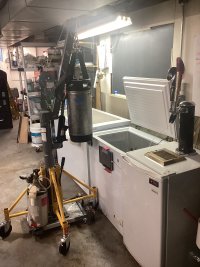hi guys,
i believe home-brewing isn't the friendliest when it comes to back safety. lifting the 5G carboy or the pot can cause long term damages. and to be honest, I'm feeling it in my back.
i bought this carboy carrier and i think its working fine for me. my issue is carrying the brewing pot off the stove. i have one of these iron cast stoves that i put on the ground, i put the pot on top of it and i get going.
my challenge is when i carry the pot off (its hot obviously) so i tend to keep it away from my body to avoid the heat. needless to say, this puts lots of pressure on my lower back.
i'm reaching out for some ideas, has anyone done a setup that's completely free from heavy-lifting of any sort? thanks
i believe home-brewing isn't the friendliest when it comes to back safety. lifting the 5G carboy or the pot can cause long term damages. and to be honest, I'm feeling it in my back.
i bought this carboy carrier and i think its working fine for me. my issue is carrying the brewing pot off the stove. i have one of these iron cast stoves that i put on the ground, i put the pot on top of it and i get going.
my challenge is when i carry the pot off (its hot obviously) so i tend to keep it away from my body to avoid the heat. needless to say, this puts lots of pressure on my lower back.
i'm reaching out for some ideas, has anyone done a setup that's completely free from heavy-lifting of any sort? thanks






























![Craft A Brew - Safale BE-256 Yeast - Fermentis - Belgian Ale Dry Yeast - For Belgian & Strong Ales - Ingredients for Home Brewing - Beer Making Supplies - [3 Pack]](https://m.media-amazon.com/images/I/51bcKEwQmWL._SL500_.jpg)






























